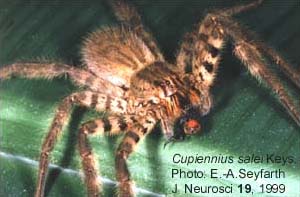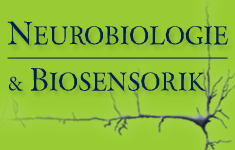- GU Home
- Faculties
- Institutes and Facilities
- Institute ZN
- Working Groups
- Kössl
- Group Members
- Seyfahrth, Ernst-August
|
Ernst-August Seyfarth |
|
Recent Research Projects 1. Cellular Mechanisms of Mechanoreception Two unresolved problems in the study of mechanoreception are how mechanical stimuli are transduced into an electrical signal, and how the dynamic properties of different mechanoreceptors are controlled. We use isolated preparations of lyriform slit sensilla from the spider leg to study fundamental mechanisms of mechanosensory transduction and adaptation in identified neurons. Recently, we have also examined the complex efferent innervation of the sensory neurons in slit sensilla. A related project deals with the function and evolution of auditory systems in vertebrates and insects (in cooperation with M. Kössl). The techniques applied in these projects are mainly electrophysiological (such as intracellular recordings of membrane potential and current) but also involve anatomical methods (immunocytochemistry and electron microscopy).
2. Neuroethology of a Simple Behavior in Spiders We examine the neuronal substrates and mechanisms responsible for relatively simple behaviors of spiders. In Cupiennius salei, a large tropical hunting spider (of which we keep a long-term breeding colony), stimulation of tactile hairs evokes reflex activity in several leg muscles. Coordinated contraction of these muscles raises the body - as in doing push-ups. Using this reliable reaction we search for the neuronal circuitry underlying body raising behavior. Electrophysiological recordings from particular leg muscles and from single, identifiable neurons in the leg ganglia have revealed interneurons whose (electrical) activation causes the muscle reflexes. Depending on the exact stimulus situation, we have found local and plurisegmental responses and activation of local and plurisegmental interneurons. The results provide a first glimpse of the architecture of particular sensory-motor elements in the fused central nervous system of spiders. 3. Case Studies in the History of Neurobiology Neuroscience research has flourished over the last few decades. While there are reports of breakthrough discoveries almost every month, the interdisciplinary roots and the intellectual history of neurobiology as a whole tend to be ignored or even forgotten. We think that case-studies, retracing and documenting the life and work of key figures in the field, are especially suited to illuminate important historical developments. Recently we have paid particular attention to the contributions and biographies of neuroscientists who were persecuted during the Nazi rule in Central Europe and were forced to pursue a new career abroad. |
| 2012, 2011, 2008, 2007, 2006, 2005, 2002, 2001 |
| Publications 2012
Huckstorf K, Kosok G, Seyfarth E-A, Wirkner CS (2012) The hemolymph vascular system in Cupiennius salei (Araneae: Ctenidae). Zool Anzeiger (in the press). http://dx.doi.org/10.1016/j.jcz.2012.03.004 |
| Publications Top |
| Publikationen 2011 Möckel, D.; Seyfarth. E.-A.; Kössl, M. (2011) Otoacoustic emissions in bushcricket ears: general characteristics and the influence of the neuroactive insecticide pymetrozine. J Comp Physiol A197: 193-202 Loesel, R.; Seyfarth, E.-A.; Bräunig, P.; Agricola, H.-J. (2011) Neuroarchitecture of the arcuate body in the brain of the spider Cupiennius salei (Araneae, Chelicerata) revealed by allatostatin-, proctolin-, and CCAP-immunocytochemistry and its evolutionary implications. Arthropod Struct Dev 40(3): 210-20 (2011). |
| Publications Top |
| Publications 2008
Kössl, M. ; Möckel, D. ; Weber, M. ; Seyfarth, E.-A. (2008): Möckel, D. ; Seyfarth, E.-A. ; Kössl, M. (2008): Strausfeld, N. J. ; Seyfarth, E.-A. (2008): Kössl, M. ; Möckel, D. ; Weber, M. ; Seyfarth, E.-A. (2008): Stollewerk, A ; Seyfarth, E.-A. (2008): |
| Publications Top |
| Publications 2007
Zottoli, S. J. ; Cioni, C. ; Seyfarth, E.-A. (2007): Möckel, D. ; Seyfarth, E.-A. ; Kössl, M. (2007): Kössl, M. ; Coro, F ; Seyfarth, E.-A. ; Nässig, W. A. (2007): Möckel, D. ; Seyfarth, E.-A. ; Kössl, M. (2007): Möckel, D. ; Kössl, M. ; Seyfarth, E.-A. (2007): |
| Publications Top |
| Publications 2006
Weber, M. ; Baumgarten, D. ; Winter; H. ; Kössl, M. ; Seyfarth, E.-A. (2006): Seyfarth, E.-A. (2006): Möckel, D. ; Seyfarth, E.-A. ; Kössl, M. (2006): Seyfarth, E.-A. (2006): Peichl, L. ; Seyfarth, E.-A. (2006): |
| Publications Top |
| Publications 2005
Weber., M. ; Kössl, M. ; Volknandt, W. ; Seyfarth, E.-A. (2005) Loesel, R. ; Strausfeld, N. J. ; Seyfarth, E.-A. ; Agricola, H.-J. (2005): |
| Publications Top |
| Publications 2002
French, A. S. ; Torkkeli, P. H. ; Seyfarth, E.-A. (2002): Panek, I. ; French, A. S. ; Seyfarth, E.-A. ; Sekizawa, S. ; Torkkeli, P. H. (2002): Fabian-Fine, R. ; Seyfarth, E.-A. ; Meinertzhagen, I. A.(2002): Seyfarth, E.-A. (2002): Seyfarth, E.-A. ; Peichl, L.(2002): |
| Publications Top |
| Publications 2001
Höger, U. ; Seyfarth, E.-A. (2001): Buchholtz, E. A. ; Seyfarth, E.-A. (2001): |
| Publications Top |
FB15
Arbeitskreis Neurobiologie und Biosensorik
Institut für Zellbiologie und Neurowissenschaft
Biologicum, Campus Riedberg
Gebäudeteil A, 3. Stock
Max-von-Laue-Str. 13
60438 Frankfurt am Main
T +49 69 798-42050
E-Mail
- Studying at Goethe University
- International applicants
- Faculties
- Overview of study programmes
- Programme for refugees
- GRADE
- Goethe Business School (continuing education)
- Research at Goethe University
- Scientific news
- Goethe Welcome Center (for international researchers)
- Collaborative research projects
- Individual research
- Visiting fellowships
- Endowed chairs
- About the University
- News-in-brief
- University administration
- Campus locations
- Campus life
- University archives (German)
- Rhine-Main-Universities







